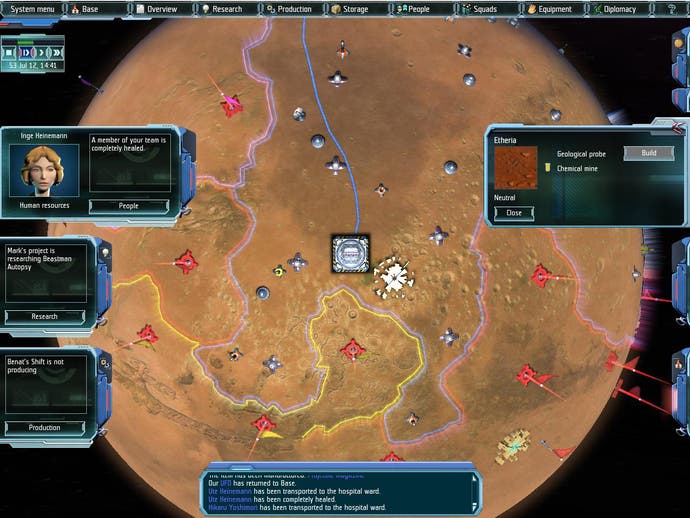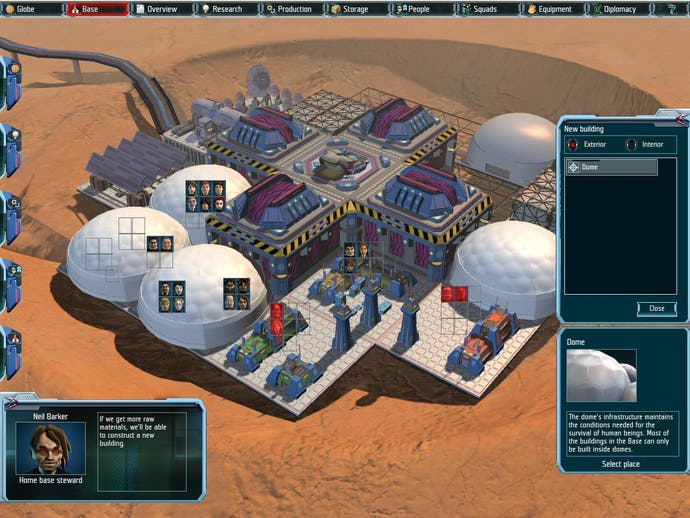UFO: Afterlight
Beagle 2 never stood a chance.
Here's a daft hypothetical question for you. If, for the rest of the year, you could only play games made in one country, and that country couldn't be one of the big four (America, Japan, Canada, and the UK) which nation would you choose? Being a lover of strategy and simulations, Russia's pretty tempting (1C:Maddox, Eagle Dynamics, Nival...) as is Sweden (home to Simbin, DICE and Paradox). Ultimately though, I think I'd probably have to plump for the Czech Republic. Eleven months of nothing but Operation Flashpoint/Armed Assault, Hidden & Dangerous 2, Mafia, and Altar's UFO series would be rather agreeable I reckon.
Illegal aliens
Afterlight, the third UFO title, would be a particularly useful game to have in your ration pile because it satisfies several different appetites at the same time. Half globe-trotting grand strategy, half tactical wargame, half RPG, and half management sim (Mr Birch, my old maths teacher, would be so proud of me) it blends genres with the same effortless proficiency its inspiration displayed 14 years ago. As in X-COM, the name of the game is battling alien invaders with a band of soldiers, boffins, and mechanics. The twist on this occasion is that you and your outfit are invaders too. Exiled to Mars by a race of grey-skinned, almond-eyed ETs known as the Reticulans (see UFO: Aftershock for the full back-story) you quickly find yourself at odds with the mysterious locals. Later other immigrants arrive and the turf war gets really complicated.

Conflict revolves around the territories that patchwork the Martian surface. The more of these you control, the more resources you have at your disposal to spend on base enhancement and the equipping and training of your band of bold refugees. Initially conquest is dead simple. Just roll a vehicle into an unoccupied region and it's yours to develop. Problems arise when the neutral areas run out and claimed territories start getting infiltrated. When a message comes through that one of your regions has been invaded it's up to you to rustle-up a posse from your base personnel, kit them out, and get them onto an outbound shuttle (the 'UFO'). This vessel then chugs across the spherical strat-map (the 'geoscape') and touches down, triggering the start of delicate combat choreography of the Jagged Alliance variety.
Actually the skirmish choreography doesn't have to be JA-like or particularly delicate. Afterlight can do slow and turny, fast and fluid, or anything in between. Essentially, you choose when you want the action to freeze. Want breaks every time a team member gets hit, a new threat is detected, or a move order is completed? Set the appropriate pause parameters in the options menu and you've got them. After complete fluency? Just deselect all interruptions. The system is great once you've got the hang of it but can be rather alarming at first. By default the game pauses at every possible juncture meaning firefights are horribly fragmented until you've adjusted the settings.
Poor boffins = more coffins

So that's the grand strategy and the tac level side of things - what about the RPG and management dimensions? Well, assuming your away team gets home, it will arrive back with pocketfuls of experience and training points. These can be used to inflate a range of core stats (dexterity, strength, intuition, etc) and enrol on courses at the base's educational facility. Over time individuals, including droids and the odd alien recruit, can be moulded into all kinds of specialists. For every stealthy sniper, beefy shotgun thug, or psi-resistant medic you fashion you also need to nurture a similarly capable backroom boy/girl/thing. Scientists and technicians research new blueprints, man the workshops that turn those blueprints into equipment, and crew the vehicles that drive out into the dusty wastes to build the mines and chemical plants that produce the raw materials to supply the workshops that swallow the spiders that catch the flys that... errr... Oh, you got the idea. Boffins and erks are vital to the functioning of a flourishing Mars outpost.
In terms of scope and replayability, Afterlight is up there with the likes of Total War. Decisions made in one area reverberate in countless others. Though a plot does stick its oar in occasionally, you're basically free to expand as you see fit and forge alliances with whomever you choose (oh yes, there's diplomacy too). The unfortunate yet tolerable price of all this freedom and power is a rather sprawling interface and a somewhat uneven difficulty curve. Conducting base business means flitting backwards and forwards between ten screens. A less atomised GUI, a few more automation options, and better tooltips would have made keeping on top of things a lot simpler.

The difficulty curve issues arise mainly on the battlefield. Much of the early opposition simply isn't tough or clever enough to ensure exciting scraps. When the resistance does eventually stiffen it stiffens frighteningly quickly. One day your squads are turkey-shooting gangs of bovine beastmen and swarms of feeble spiderbots, the next they're legging it from fearsome bulletproof spheres that roll up, leap to chest height and sprout giant heart-skewering spikes. Possibly the scariest difficulty hike comes when you first cross buzzsaws with the Reticulans. Within seconds of encountering this new foe my longest-serving veteran (a chap I'd shepherded through dozens of engagements) had pulled a bomb from his backpack, planted it at the feet of his comrades and blown them all to kingdom-come (he'd been mind-controlled). The team members that survived this tea-spillingly shocking incident were soon cut-down by volleys of lethal rockets. Time for a quickload, a 'mission abort', and a serious rethink.
Even if the quality of the opposition rose a little more uniformly there'd still be some room for improvement within the skirmishes. Compared to the dramatic aggro offered by tactical peers like Silent Storm, Afterlight's rumbles can a feel a tad anaemic. Modders can probably do something about the weedy weapon sounds and the slightly bland AI (enemies seldom seek cover) but the shortage of destructible scenery won't get rectified in a hurry.

When a game covers this much ground, a few weaknesses here and there are inevitable. Yes, you'll find sleeker interfaces and more engaging gunfights in titles such as Silent Storm, Faces of War, and Jagged Alliance 2, but none of those games come with anything half as involved or absorbing as Afterlight's amazing strategic layer.
So, if lately you've found yourself craving strategy titles that don't revolve around steering drag-selected clusters of friendly units towards enemy bases, then this one is well-worth investigating. Those that have foolishly agreed to play nothing but Latvian games until 2008 should start beating their foreheads against a convenient wall or tabletop round about... now.
